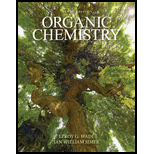
Concept explainers
(a)
To determine: An orbital diagram of allene and the two perpendicular ends in orbital diagram.
Interpretation: An orbital diagram of allene is to be drawn and the two perpendicular ends in orbital diagram are to be shown.
Concept introduction: Allenes are the compounds in which two adjacent double bonds share the common carbon atoms. These are also known as cumulative dienes. Cumulative dienes are different from conjugated dienes because conjugated dienes comprise double bonds separated by one single bond.
(b)
To determine: The two enantionmers of
Interpretation: The two enantionmers of
Concept introduction: Allenes are the compounds in which two adjacent double bonds share common carbon atoms. These are also known as cumulative dienes. Cumulative dienes are different from conjugated dienes because conjugated dienes comprise double bonds separated by one single bond.
Want to see the full answer?
Check out a sample textbook solution
Chapter 15 Solutions
Organic Chemistry&mod Mstgchem Ac Pkg
- 1. Draw the structure of (4S)-1-bromo-4-methylhexane a. Draw the substitution product that would form upon reaction with NaOCH3 in DMSO solvent. (Include stereochemistry) b. Would this reaction be SN1 or Sn2? C. Draw a detailed step-wise mechanism for this substitution reaction. Be sure to include all steps, formal charges, and show the movement of electrons with curved arrows. Draw in any lone pairs of electrons that are directly involved in the reaction. or distributed d. Draw the elimination product that would form upon reaction of (4S)-1-bromo-4- methylhexane with KOC(CH3)3 in HOC(CH3)3 solvent. (Include tereochemistry) e. Would this reaction be E1 or E2? f. y not be shar Draw a detailed step-wise mechanism for this elimination reaction. Be sure to include all steps, formal charges, and show the movement of electrons with curved arrows. Draw in any lone pairs of electrons that are directly involved in the reaction.arrow_forwardFor the following diene a. Draw all reasonable resonance structures, including electron-pushing arrows. b. Determine the hybridization of the indicated atoms. c. Circle the resonance structure that is the greatest contributor to the resonance hybrid and provide a brief explanation for your choice. my 3.arrow_forward3) For the species shown, do the following. a. Draw the complete MO picture and energy diagram for the л-system b. Label each orbital as bonding, antibonding, or non-bonding. c. Label the HOMO and LUMO where appropriate. d. Designate whether the molecule will react more readily with a nucleophile or an electrophile and designate which atom or atoms it will react most readily with using evidence from the molecular orbital diagram.arrow_forward
- A reaction flask contains 2-bromopentane in an ethanolic solution of sodium ethoxide at room temperature and result in the formation of two olefnic products. What is responsible for the formation of major and minor products. A. Different activated complex involved in the mechanism. B. Bimolecular nucleophilic substitution reaction. C. Bimolecular elimination reaction D. The presence of sodium ethoxide. E. The hybridization nature of secondary carbocationarrow_forwardDraw structural formulas for the diene and dienophile that combine in a Diels-Alder reaction to form the product shown. In progress Diene + Dienophile CH3 • Consider E/Z stereochemistry of alkenes. • Draw one structure per sketcher. Add additional sketchers using the drop-down menu in the bottom right corner. • Separate multiple products using the + sign from the drop-down menu.arrow_forward4. Draw an electron-pushing mechanism with curved arrows for the following Diels- Alder/retro-Diels-Alder reaction. Show the products of each step.arrow_forward
- a. Write a second resonance structure for the following carbocation. b. Is the charge shared equally by both allylic carbons? If not, which one bears more of the charge? Select the single best answer. Both carbocations carry the same amount of charge. The structure on the left in Part 1 contributes more to the resonance hybrid. The structure on the right in Part 1 contributes more to the resonance hybrid.arrow_forwardThe diene shown below will NOT react in a Diels-Alder reaction. Why not? Select one: OA. The compound is lacking in electron withdrawing groups. B. The compound is not a conjugated diene. O C. The compound is lacking in electron donating groups. OD. This compound cannot adopt the s-cis conformation.arrow_forward1. a. Interpret the table and determine the major diene percentage for eucalyptus oil. Relevant peaks should be some time after the 2 second mark. b. What is the mass of the major diene? (The molecular mass of eucalyptus oil is 136.2 g/mol.) c. If maleic anhydride has a 1:1 ratio with eucalyptus oil and 5 g are used in an experiment, how much maleic anhydride should be used?arrow_forward
- Draw structural formulas for the diene and dienophile that combine in a Diels-Alder reaction to form the product shown. Diene + Dienophile H • Consider E/Z stereochemistry of alkenes. • Draw one structure per sketcher. Add additional sketchers using the drop-down menu in the bottom right corner. • Separate multiple products using the + sign from the drop-down menu.arrow_forwardIn Chapter 18, we will learn about the hydrolysis of acetals to aldehydes and ketones. Four of the seven steps in the mechanism for this process are shown in the conversion of acetal A to hemiacetal E. a.Add curved arrows for each step. b.Draw another resonance structure for C. c.Identify the nucleophile and electrophile in Step [3]. d.Which steps are Brønsted–Lowry acid–base reactions?arrow_forwardComplete the following for the below reaction. i. draw the complete Molecular Orbital diagram with electron filling, nodes and phasing. ii. label each level with the number of bonding and antibonding interactions iii. label each level as bonding, nonbonding or antibonding, and HOMO & LUMO iv. Using the correct level, show how the cyclization occurs to give cyclohexadiene and indicate whether the product is cis or trans. heatarrow_forward
 Organic Chemistry: A Guided InquiryChemistryISBN:9780618974122Author:Andrei StraumanisPublisher:Cengage Learning
Organic Chemistry: A Guided InquiryChemistryISBN:9780618974122Author:Andrei StraumanisPublisher:Cengage Learning
